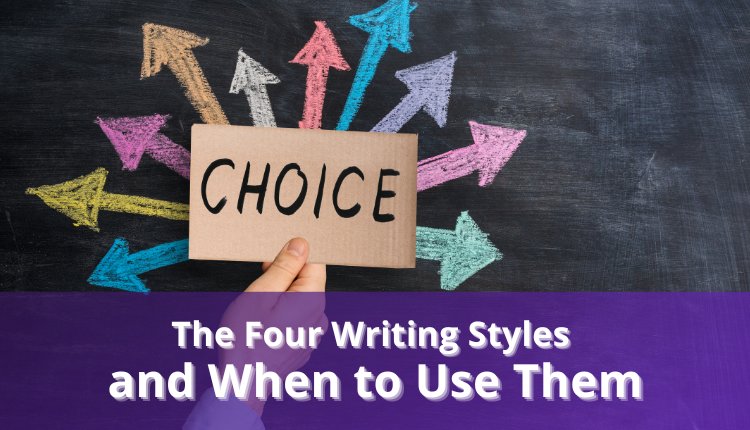The internet and technology have changed our lives so much that we read all day, every day. We’re surrounded by content, ranging from poems, fiction, and news articles to blogs like this one. While the world is full of writing, in actuality, there are only four main writing styles.
This might sound confusing. How can all of the world’s writing just fall into four styles? There is certainly some overlap between them, and the categories themselves are very broad. Regardless, each style is still distinctive and used for a different purpose.
Let’s look at the four writing styles, explore some examples for each one, and discuss when you should use them.
Table of Content:
What are the Four Writing Styles?
The four writing styles are expository, narrative, persuasive, and descriptive. They can be defined as follows:
Expository: Expository writing informs the audience about a particular topic. It cites statistics, provides evidence, and relates factual information. It does not include the writer’s opinion. This blog you are reading is an example of expository writing. In addition, restaurant menus, product descriptions, technical how-to guides, and cookbooks are all types of expository writing.
Narrative: Narrative writing is used to tell a story. Narrative writing includes characters, a setting, and a plot. Memoirs, novels, and many television shows use narrative writing. Narrative writing can be fact or fiction.
Persuasive: Persuasive writing aims to persuade or convince the audience to agree with a specific opinion or position. Persuasive writing includes opinions, facts and justifications to support the opinion. Some examples include newspaper editorials and letters of recommendation.
Descriptive: Descriptive writing is used to describe a person, place, or thing. It includes a high level of detail and is very specific, as it tries to paint a picture using words. Poems, lyrics, and a great deal of fiction fall into this category.
These are just a few examples of the type of writing that falls into each category.
Should You Use a Narrative, Persuasive, Expository, or Descriptive Writing Style?
As you can see from the brief definitions above, each of these writing styles has its own purpose and use. How do you choose which writing style is right for you? The writing style that you choose will depend on your target audience and the goal of your writing.
Whom do you hope to read your writing, and what do you want them to learn? Do you want to tell a personal story? Convince someone to change their mind about an issue? Describe a place or person? Or teach someone something new?
Once you know your aim and intended audience, you can choose the most appropriate writing style to achieve your goal.
If you’re still unclear about the exact difference between each of these writing styles, don’t worry! We have some examples to help you understand each style of writing.
Persuasive writing: This opinion article about the importance of vaccinating children against COVID-19 utilizes statistics and data about the pandemic and the safety and efficacy of the vaccine to support the author’s argument. The author acknowledges potential counterarguments (those vaccinated can still get sick) and responds to them (vaccines prevent the worst outcomes).
Descriptive writing: This short story by Carmen Maria Machado utilizes poetic language to create powerful images. The story, written for adults, uses metaphorical expressions (everything is soft, like a fresh oil painting) to describe the scenes and powerful language to help the reader envision the scenes.
Narrative writing: This narrative essay includes a setting, a series of events, and characters, which all of which combine to tell the reader a story about something that happened. In this case, it is a story about the author realizing how others perceive her and her mother because of an event.
Expository writing: This blog offers readers tips and tricks on how to write a scientific manuscript. It uses clear, simple language to target non-native English speakers who write scientific articles. It does not put forth an opinion or argument.
Make Your Writing Clear and Compelling
Content can be written in a variety of ways, which is why it is essential to understand what you hope your writing will accomplish when choosing a writing style. All four writing styles differ in tone, word choice, and even grammar structure.
Expository writing, like an academic article aimed at an audience of other academics, will convey complex ideas utilizing highly technical language. In contrast, a narrative targeting young children might use creative words to express a simple storyline.
The line between the writing styles is not always clear-cut. While academic writing in the hard sciences is likely to take a dry tone, academic writing in the social sciences may very well blur the line between itself and persuasive writing. This is because social scientists sometimes write about topics that have been politicized, like the causes of poverty or social behaviors.
Persuasive writing, like newspaper editorials, can use the narrative writing style to tell a story that bolsters the main point of the article. There is nothing wrong with combining writing styles! Many writers do so effectively to better convey their intended message to their target audience. The only note of caution is to make sure that your writing doesn’t become muddled or unclear.
If you need more help ensuring that your writing style, tone, word choice, and grammatical structure are all appropriate for your intended audience, AI writing tools can help you while you write. These days, AI writing tools have gone beyond simple spelling and grammar checking capabilities.
Some AI writing tools like Trinka can check your paper for tone, style, and word choice. Whether you’re writing about the latest scientific development or your memoirs, AI writing tools can help you refine your writing style for your target audience and purpose. Try one today for your next writing project.

